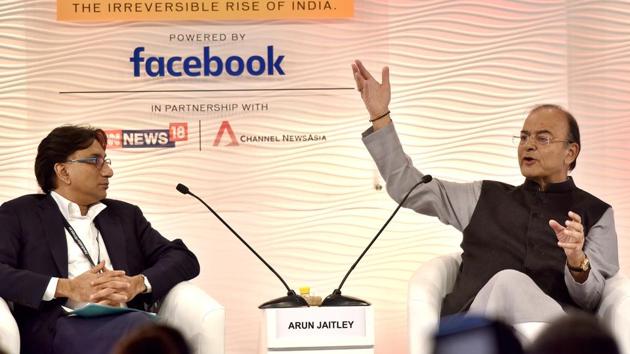HTLS 2017: GST slabs could come down to three, says Arun Jaitley
Finance minister Arun Jaitley, at the HT Leadership Summit, said GST council could consider merging slabs of 12% and 18% into one rate and cutting the number of items taxed at the highest slab of 28%.
Finance minister Arun Jaitley on Thursday hinted that tax rates under the goods and services tax (GST) could be rationalized to three slabs as revenues under the new indirect tax regime stabilize.

Jaitley indicated the GST Council could consider merging the current slabs of 12% and 18% into one rate and reduce the number of items that are taxed under the highest slab of 28%.
“We started the rationalization (of GST rates) ahead of schedule. Future rationalization will depend on how the revenue moves. We have thinned down the 28% bracket. Going ahead, we will rationalize it further to probably tax only luxury and demerit goods at 28%. We have to maintain revenue neutrality,” Jaitley said at the Hindustan Times Leadership Summit.
“Do you have scope of merging 12% and 18% and come to an interim rate? You have 5%, then this ‘X’ rate after merging 12% and 18% and then the very thin slab of 28%. Eventually that will be the direction,” Jaitley said, adding the speed of this rationalization will depend on how revenues pick up.
Earlier this month, the GST Council brought down the number of items that are taxed under the 28% slab to 50 from 227, reducing the rate on items ranging from soaps and shampoos to tyre tubes. At present, GST has five tax slabs—0%, 5%, 12%, 18% and 28%. Besides, a cess is levied on some sin and luxury goods over and above the tax rate of 28%.
Jaitley defended the government’s decision to bring in multiple tax slabs at the beginning of the implementation of the tax on 1 July.
“In a highly differentiated society like India, we cannot have a single rate. The Congress party raised this in Parliament, asking for a single rate. I asked them can you have a GST in India where a Mercedes car and a hawai chappal are taxed at the same rate?” Jaitley said.
GST removed barriers to trade in goods and services across states, subsuming a range of central, state and local taxes and unifying the country into a common market. But its implementation has confronted teething problems, prompting the GST council to make several revisions to address concerns raised by taxpayers.
Jaitley pointed out that the government has been able to minimize the inflationary impact because of the multiple rate structure.
“By this process, we have been able to avoid the inflationary impact. The teething problems are transitional (and not necessarily because of the multiple rate structure,” he said.





